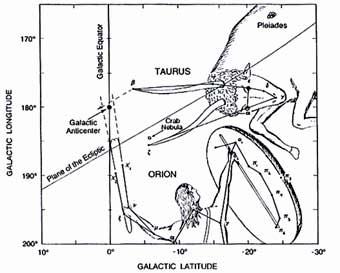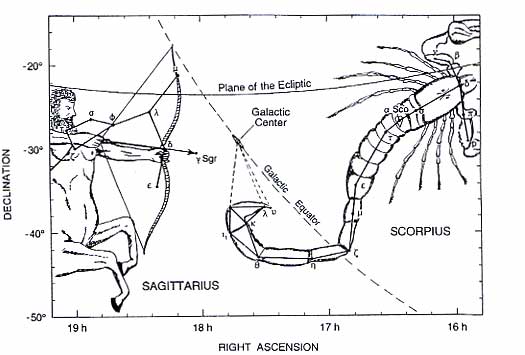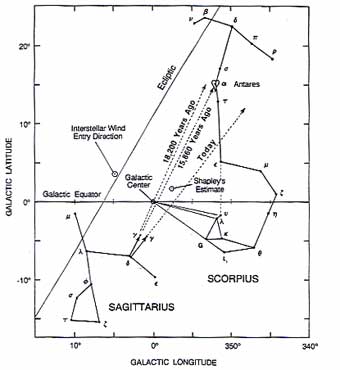THE
CHARGE OF THE BULL
About
Equinoctial Precession
The equinoxes
do not precess linearly with time. Instead, their rate of precession
increases to a maximum and then decreases to a minimum over
a period of 38,830 years as the inclination or “obliquity”
of the Earth’s axis relative to the ecliptic oscillates
between a minimum rate of 73.75 years per degree, while in 26,550
B.C. they were precessing at their maximum rate of 68.8 years
per degree. On the average, they take 71.28 years to move one
degree, not 72 years as is often quoted. Hence one precessional
Great Cycle actually spans an average of 25,660 years. However,
more recently this cycle has been lasting longer than this average.
Measuring back from 635B.C., computer simulations indicate that
the preceding precessional half cycle took 13,195 years to complete,
365 years longer than the time for an average half cycle.

A map showing
the constellations of Taurus and Orion as they appeared 15,860
years ago. The projection parallel to the ecliptic of Taurus’
upper horn and the upward projection of Orion’s club appear
to indicate the galactic anticenter.
The
GALACTIC CONNECTION
Ancient
Knowledge of the Galactic Plane’s Location
The design
of Scorpius also suggests that these ancient constellation artisans
knew the precise orientation of the galactic plane. The Scorpion’s
thorax, formed by the stars Sigma, Alpha, Tau, and Epsilon Scorpii
, 15,860 years ago was oriented almost exactly from Epsilon
Scorpii, to the tip of the stinger, Upsilon Scorpii would have
been off normal by just four thousandths of a degree! Epsilon
Scorpii has the highest proper motion of all stars in the Scorpius
and Sagittarius constellatons, so it could very well have been
intended as a sighting star, with Upsilon Scorpii as its marker
point.

The constellations
Scorpio and Sagittarius plotted in celestial coordinates.

A map showing
the constellations of Scorpius and Sagittarius, as they would
have appeared 15,860 years ago. Sightings are plotted for the
Archer’s arrow for various dates. Shapley’s Galactic
center position estimate is shown for comparison. Note that
this map is plotted in galactic coordinates rather than celestial
coordinates to represent the constellations with the least amount
of cartographic distortion.
The zodiac’s
moving-arrow pointer in Sagittarius is quite a clever device.
Not only does it indicate the approximate location of the Galactic
center, but it also serves as a chronometer that designates
an important date in the past.
From Earth
Under Fire by Paul La Violette
Ancient
Technology Index
|